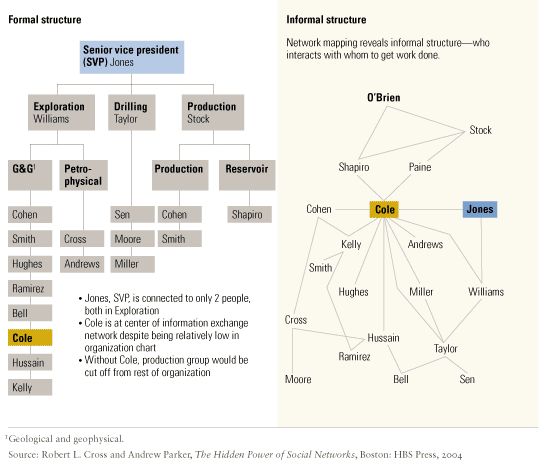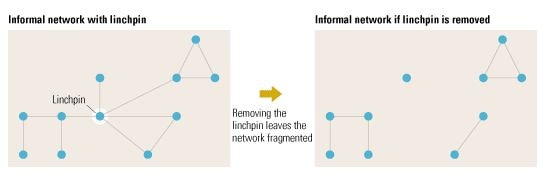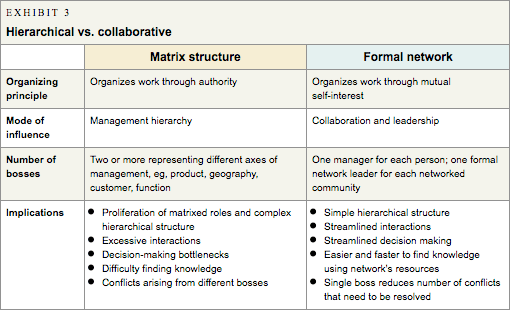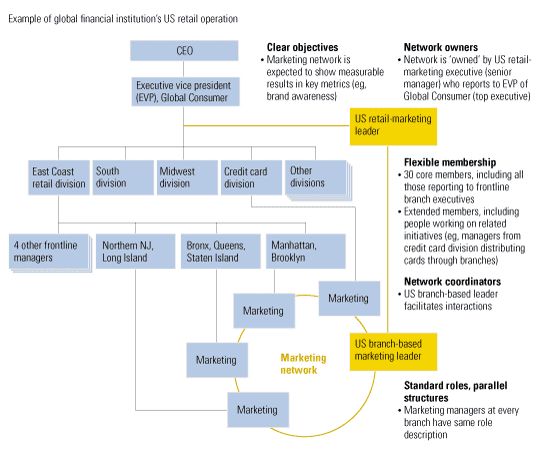In any professional setting, networks flourish spontaneously: human nature, including mutual self-interest, leads people to share ideas and work together even when no one requires them to do so. As they connect around shared interests and knowledge, they may build networks that can range in size from fewer than a dozen colleagues and acquaintances to hundreds. Research scientists working in related fields, for example, or investment bankers serving clients in the same industry frequently create informal—and often socially based—networks to collaborate.
Most large corporations have dozens if not hundreds of informal networks, which go by the name of peer groups, communities of practice, or functional councils—or have no title at all. These networks organize and reorganize themselves and extend their reach via cell phones, Blackberries, community Web sites, and other accessories of the digital age. As networks widen and deepen, they can mobilize talent and knowledge across the enterprise. They also help to explain why some intangible-rich companies, such as ExxonMobil and GE, have increased in scale and scope and boast superior performance.1
As we studied these social and informal networks, we made a surprising discovery: how much information and knowledge flows through them and how little through official hierarchical and matrix structures. As we used surveys and e-mail analysis to map the way employees actually exchange information and knowledge, we concluded that the formal structures of companies, as manifested in their organizational charts, don’t explain how most of their real day-to-day work gets done.
So it’s unfortunate, at a time when the ability to create value increasingly depends on the ideas and intangibles of talented workers, that corporate leaders don’t do far more to harness the power of informal networks. Valuable as they are, these ad hoc communities clearly have shortcomings: they can increase complexity and confusion, and since they typically fly under management’s radar, they elude control.
But companies can design and manage new formal structures that boost the value of networks and promote effective horizontal networking across the vertical silos of so many enterprises today. By building network infrastructures, assigning “leaders” to focus discussion, and combining hierarchy and collaboration to bring together natural professional communities, formalized networks serve as an organizing structure for collaborative professional work. They can replace cumbersome and outdated matrix structures, facilitate the creation and sharing of proprietary information and knowledge, and help build more and better personal relationships among the members of a community. Most important, they can enable leaders to apply the energy of diverse groups of professionals and managers to realize collective aspirations.
The long and short of informal networks
Personal social networks, both within and outside of companies, increase the value of collaboration by reducing the search and coordination costs of connecting parties who have related knowledge and interests. They don’t necessarily fit into the organizational chart. Consider the case of an energy company staffer we call Cole (Exhibit 1). Although he sits relatively far down in the formal company structure, he acts as the hub in an informal network because he has knowledge that others find valuable. Without him, the production group would be cut off from the rest of the organization. His boss Jones, the unit’s senior vice president, is connected in the informal network to only two people, both in exploration. This is increasingly typical in today’s large, sprawling corporations. Informal networks, slipping through the back channels, cross the lines of geography, products, customer groups, and functions—where the action is—and even through the thick silo walls of vertically oriented organizations.
A revealing map

But though informal networks help many of the largest companies capture wealth, they also cause severe headaches. As tens of thousands of individuals search for knowledge and productive personal relationships in social networks, they generate much of the overload of e-mails, voice mails, and meetings that make today’s large companies more complex and inefficient. At one large company, we conducted a network analysis of more than 1,000 people across a number of business units around the world to gauge the frequency and quality of the interactions that generated decisions about business planning and other processes. Nearly half of the interactions were not central to making decisions. This analysis suggested that redesigning the processes to eliminate or reduce the noncore interactions could result in savings of tens of millions of dollars and shorten the time to make the decisions.
Part of the problem is that informal networks, as ad hoc structures, essentially rely on serendipity, so their effectiveness varies considerably. In large companies a number of informal networks may form on related topics but never integrate. People with valuable knowledge or skills may not join the most appropriate network, belong to other informal networks, or fail to discover that a network exists. What’s more, companies typically underinvest in the capabilities needed to make networks function effectively and efficiently. An informal network often has crucial members, such as Cole, who serve as hubs to connect participants, but such members can hobble or even undermine the network if they become overloaded, act as gatekeepers, horde knowledge to gain power, or leave the company (Exhibit 2).
The missing link

The greatest limitation of these ad hoc arrangements is that they can’t be managed. They may not be visible to management, and even when they are it’s hard for corporations to take full advantage of them. Unintended barriers, corporate politics, and simple neglect can keep natural networks from flourishing. At worst, informal networks can make dysfunctional organizations even more so by adding complexity, muddling roles, or increasing the intensity of corporate politics.
Formal networks
The specific objective of designing and establishing formal networks is to increase the value and lower the costs of collaboration among professionals. Since formal networks stimulate interactions that the organization sponsors and encourages, they can be managed.
A leading petrochemical company, for example, recently designed more than 20 formal networks, ranging in size from 50 to several hundred people, to focus on specific work areas so that employees could share best practices. This was critical, because the networks could minimize downtime in these areas. In one case the company measured the impact of networks on engineers at an oil well, who used them to find experts with the knowledge needed to get the well back into production in two days rather than the anticipated four.
These networks succeeded because the company formed them around focused topics closely related to the way work was carried out at the wells. Management also appointed the networks’ leaders, gave the members training, carefully identified the members of each network across the geographically dispersed company, made technology investments, and sponsored a knowledge-sharing team that collected and disseminated best practices.2
Matrix decoded
Because formal networks cross line structures, they can easily be mistaken for matrix organizational entities. But the differences are significant and start with the organizing principles that underlie each (Exhibit 3). A matrix organizes work through authority and is therefore principally based on management hierarchy. A formal network organizes work through mutual self-interest and is therefore principally based on collaboration.
Hierarchical vs. collaborative

In classic matrix organizations, managers and professionals have two or more bosses who have authority over their work; the chief financial officer of a business unit, for example, might report both to its line manager and to the corporate finance chief. These matrixes represent different axes of management, such as products, geography, customers, or functions. Hierarchical direction comes from two different sources, and the person in the middle of the matrix must resolve any conflicts. In hierarchically organized companies, matrix management became popular because no matter how well organized their line structures may have been by functions, geography, customers, or products, they felt they needed secondary axes of management to stretch horizontally across the enterprise and thus make it possible to integrate other work activities.
Matrix management worked reasonably well from its advent in the 1960s until the late 1980s, particularly because it enabled limited collaboration to take place within companies as they became increasingly aware that hierarchical managers sometimes had to coordinate their activities. Matrix structures made sense because they were used sparingly and therefore didn’t greatly confuse the hierarchical vertical line structures responsible for much of the success of large 20th-century companies.
But when globalization took hold, companies were forced to adapt to an increasingly fluid and uncertain competitive environment, so more work from different perspectives had to be integrated. As the number of professionals needing to direct much of their own work has risen, matrixed roles have proliferated. This increased the need for more interactions, and decision making now swamps the time available for matrix managers to coordinate the work personally. Furthermore, the amount of knowledge and information that must be absorbed and exchanged often exceeds the personal capacities of any individual, no matter how talented, to deal with them in a matrix structure.
Professionals who want to work horizontally across an organization currently find themselves forced to search though poorly connected organizational silos for the knowledge and collaborators they need. In many companies these matrix and other hybrid organizations have become dysfunctional. The symptoms include endless meetings, phone calls, and e-mail exchanges, as well as confused accountability for results.
A new model
Companies need to build infrastructures to create and support formal networks. Such well-designed and well-supported formal networks remove bottlenecks and take much of the effort out of networking. Rather than forcing employees to go up and down hierarchical chains of command, formal networks create pathways for the natural exchange of information and knowledge. Individual members of networks don’t have to find one another through serendipity.
Consider the US retail unit of a financial institution we’ll call Global Bank, which was organized as a matrix. Its retail-marketing managers, forced to report to a regional as well as a functional manager, often didn’t know whose authority to recognize and had little opportunity to share best practices with other marketing professionals across the organization.
In the new model (Exhibit 4) regional marketing managers still report to the branch network’s regional managers but no longer have a second boss in marketing. Instead, a branch-based formal network leader for marketing facilitates their interactions with other marketing professionals. The leader can’t give them orders but can encourage them to work for the network’s benefit (for example, by asking them to help develop new promotional materials or to find better ways of using local-advertising budgets). The marketing leader’s boss, the US retail-marketing executive, is a senior manager who owns the formal network and mobilizes marketing talent for special projects, identifies candidates for marketing positions, oversees the maintenance of the domain’s knowledge (for instance, branch signage or promotional materials), and stimulates its creation. The company, which expects the network to show measurable results in key metrics (such as brand awareness), evaluates the owner by taking into account qualitative assessments of how well this formal network operates as compared with others, as well as the expectations of corporate leaders.
Formalizing a network

Formalizing a network
To formalize a network, the company must define who will lead it—that is, the network owner—and make that leader responsible for investing in the network to build its collective capabilities, such as knowledge that is valuable for all members. The company can facilitate the development of a formal network by providing incentives for participating in it (such as community building off-sites) and for contributing to it (such as recognition for people who contribute distinctive knowledge).
Network owners facilitate interactions between members, stimulate the creation of knowledge, maintain the network’s knowledge domain, and help members do their jobs more effectively and efficiently. For a formal network to work effectively, its territory must be defined—informal networks sometimes make overlapping claims on the same activities. Furthermore, the network must have standards and protocols that describe how it should work.
Another difference between a formal network and a matrix is that the network owner isn’t a boss but rather a “servant leader.” The owner of a network doesn’t oversee its work or personally manage or evaluate the performance of individual members (except for direct reports) but may provide input to the evaluation process.
The responsibilities of the formal leader of a network are primarily limited to its activities, such as organizing the infrastructure supporting it, developing an agenda for maintaining its knowledge domain, building a training program, holding conferences, and qualifying members as professionally competent.
Despite this limited hierarchical authority, a formal network’s leader should be held accountable (together with line management) for the network’s performance. After all, the leader has great ability to help its members improve their performance and in this way can shape the organization. Much of the leader’s impact comes from controlling the investments and activities that make the members individually—and the network collectively—more effective, and much from the ability to inspire and persuade.
In professional firms, which have long used formal networks called practices, it is always possible to tell the difference between talented and average leaders. While the responsibilities might be the same, talented ones create far more vibrant, exciting practices than their average counterparts do. It is therefore entirely appropriate to hold the leader of a formal network accountable for its performance, even if the leader has no direct authority over individual members.
Connecting members to the network
In the model we propose, companies should design formal networks to extend the reach of professional work throughout the organization but not to interfere with its hierarchical decision-making processes. The idea is to achieve this extended reach by adding value for the networks’ members, not by exercising authority through hierarchical leaders.
To undertake the appropriate roles, a formal network’s leader should have a discrete budget to finance network investments, which give the leader the muscle to offer the members added value. These investments might include infrastructure, both human and technological, to support network interactions; codified knowledge in forms such as documents, internal blogs, and “networkpedias”; training for members; and activities such as conferences to build a social community. Companies can evaluate the leader’s performance by using some quantitative measures, such as the level of participation in conferences, e-mail volumes, standard measures from network analysis (for example, the number of steps it takes for any person in the network to reach anyone else), density, knowledge documents produced, and downloads. Management can also track and test the effectiveness of a network by assessing the satisfaction of its members, the effectiveness of responses to inquiries, and the ability to find appropriate partners for dialogue quickly.
But the real measure of the network’s success would be qualitative assessments, made by members and senior leaders, of its effectiveness in realizing its mission. These assessments might come in the form of stories or case studies illustrating improvements in professional productivity.
Providing structure to professional work
Just as formal hierarchical structures define management roles, formal network structures define collaborative professional ones. In this way such networks can enable large companies to overcome the problems of very large numbers by creating small, focused communities of interest integrated within larger, more wide-ranging communities—for instance, subcommunities focused on different aspects of financial services, such as wholesale and retail banking.
The number of networks employees participated in would be up to them, unless they were core members, for whom participation would be a job requirement. In other words each member would build a personal social network within the formal networks, depending on that member’s roles and professional interests. The limits of network participation are largely a function of time and interest; members would join networks that had more value to them than the opportunity costs of their time and would leave when those networks no longer had that much value.
By participating in more than one network at a time, talented workers would gain the ability to integrate knowledge and access to talent across a number of communities. A person in the retail-banking community could also be a member of a branding community, for example, and members could bring knowledge gained there into other communities.
The number of formal networks a company could create is limited only by how much management chooses to invest in them. Their number and size could vary with how well each of them serves its members—effective networks would grow in membership and interactions; ineffective ones would lose both. In this way formal networks regulate themselves. Rapid growth proves the value of a network, its leader, and the money invested in it.
Today’s mega-institutions have room for thousands of formal networks. A company with 100,000 professional and managerial employees, for example, could have 2,000 networks with 100 people apiece if each professional and manager was a member of just 2 networks. Broad networks (in fields such as finance or IT) might have thousands of members; specialized ones (say, a Turkish interest group) might have only a few dozen. Formal networked communities could form around not just customer groups, products, geography, and functional lines but also in conjunction with integrative crosscutting themes, such as risk management and global forces (nanotechnology and changing demographics, for instance).
Formal network structures can mobilize employees to generate value by propagating knowledge and its creators all over the enterprise. Rather than pushing knowledge and talent through a hierarchical matrix, formal networks let employees pull these necessities toward them.

